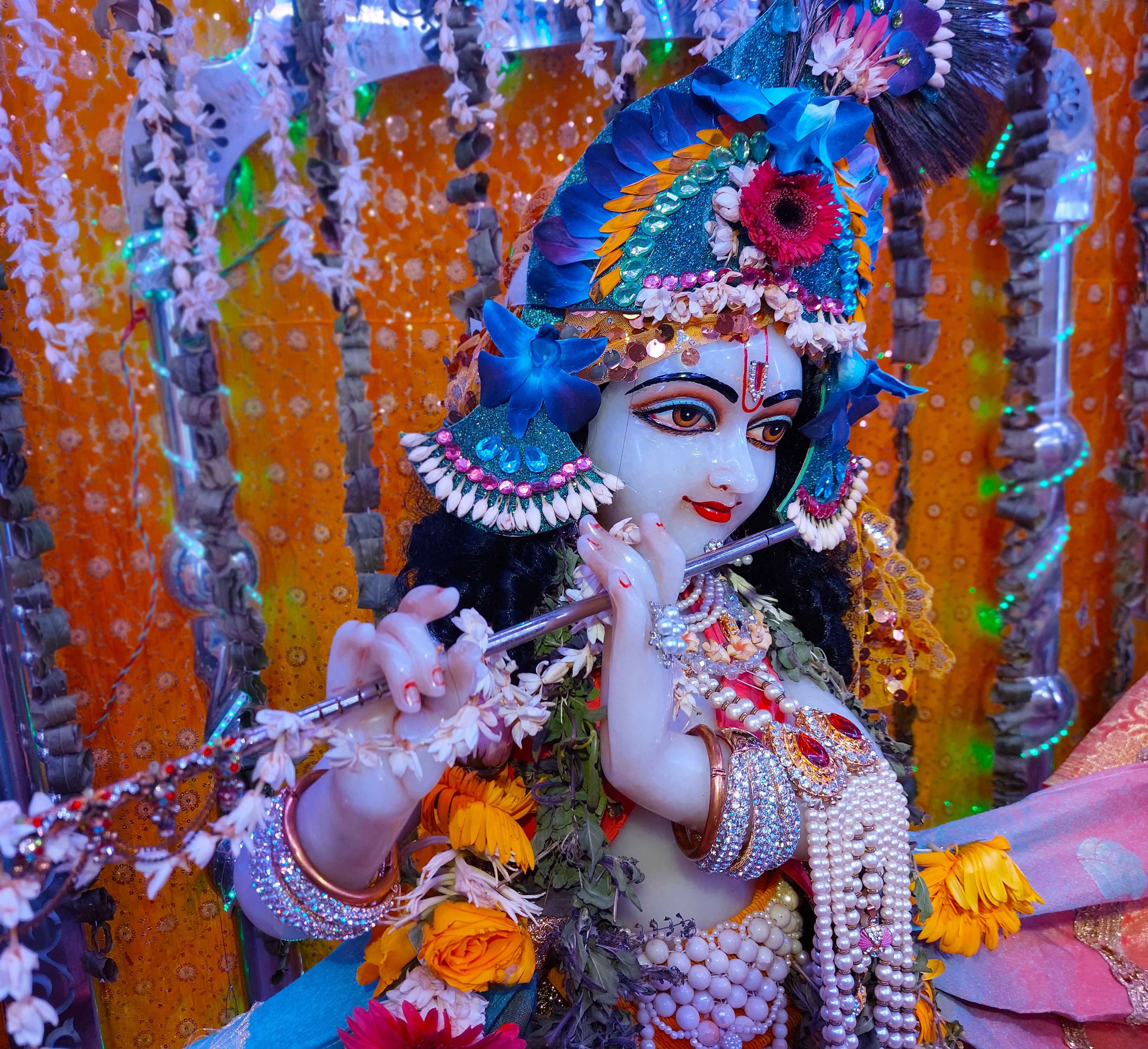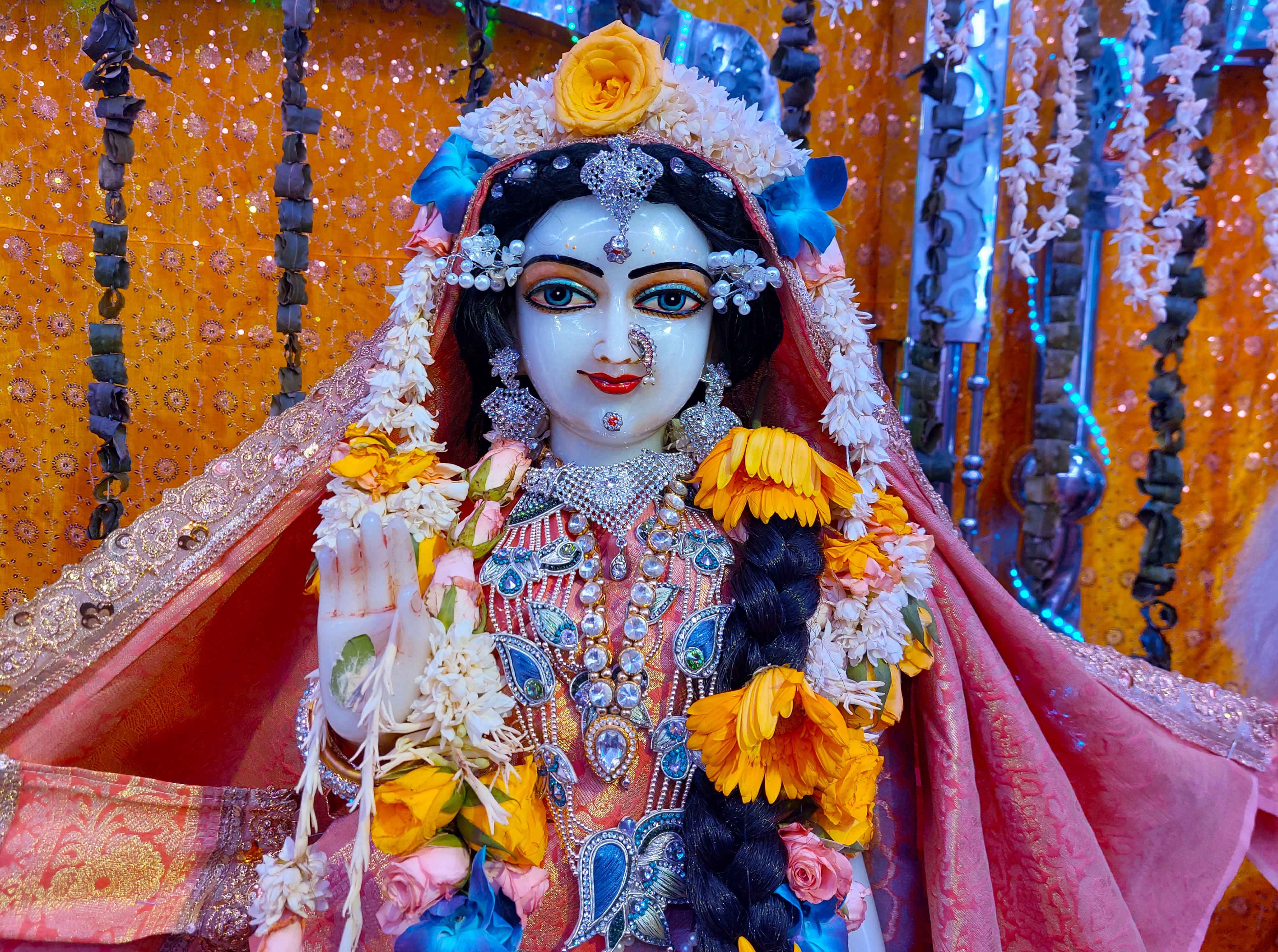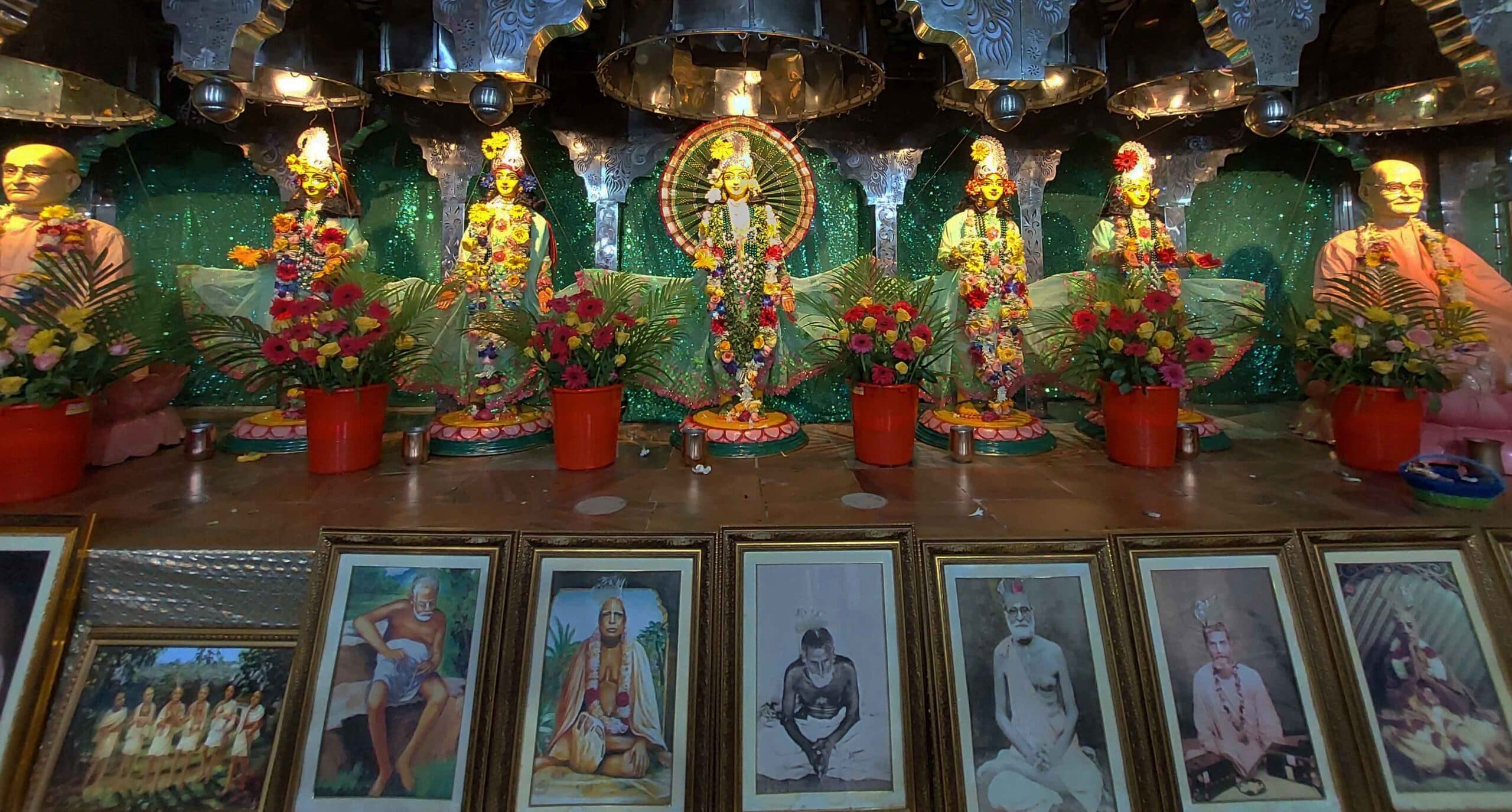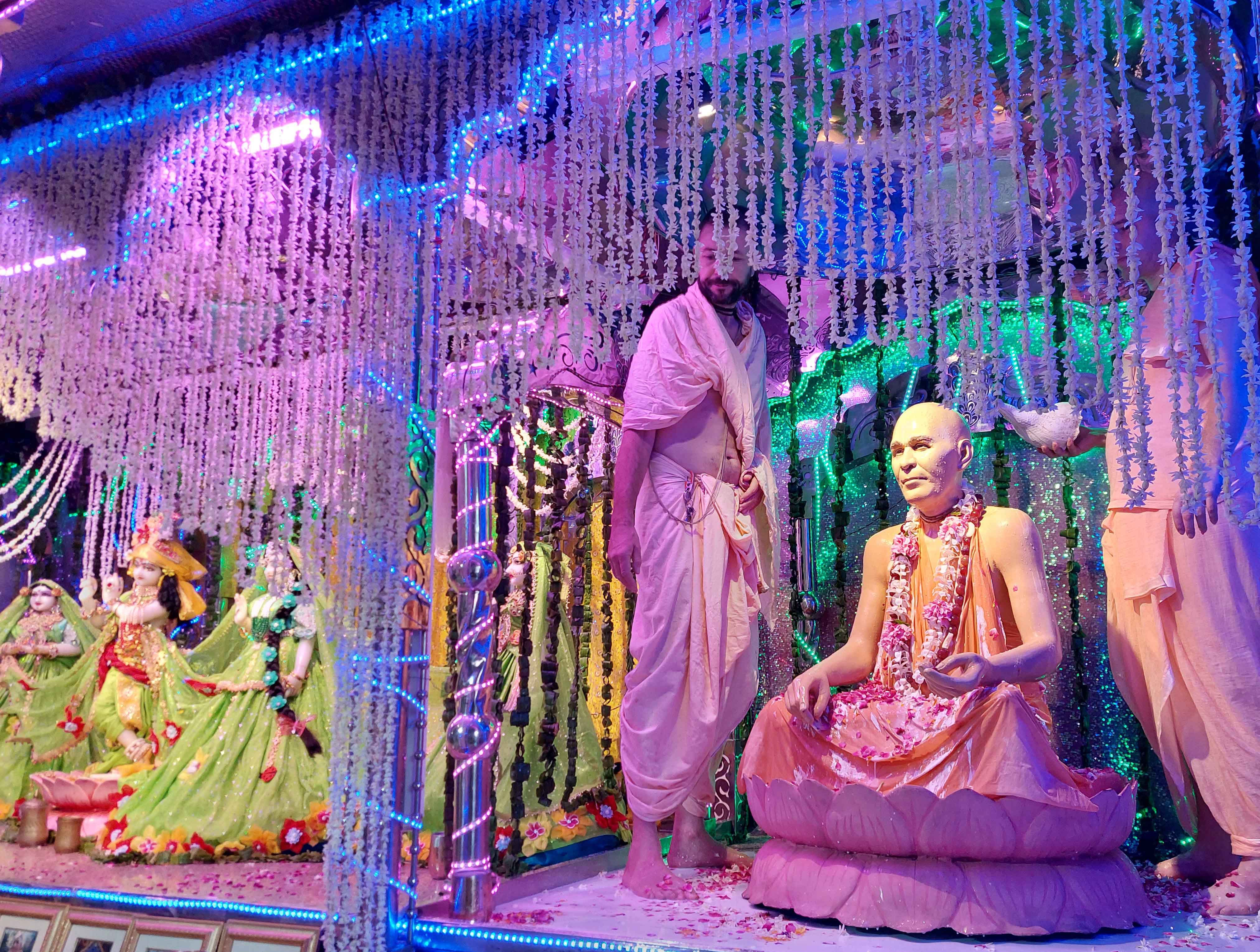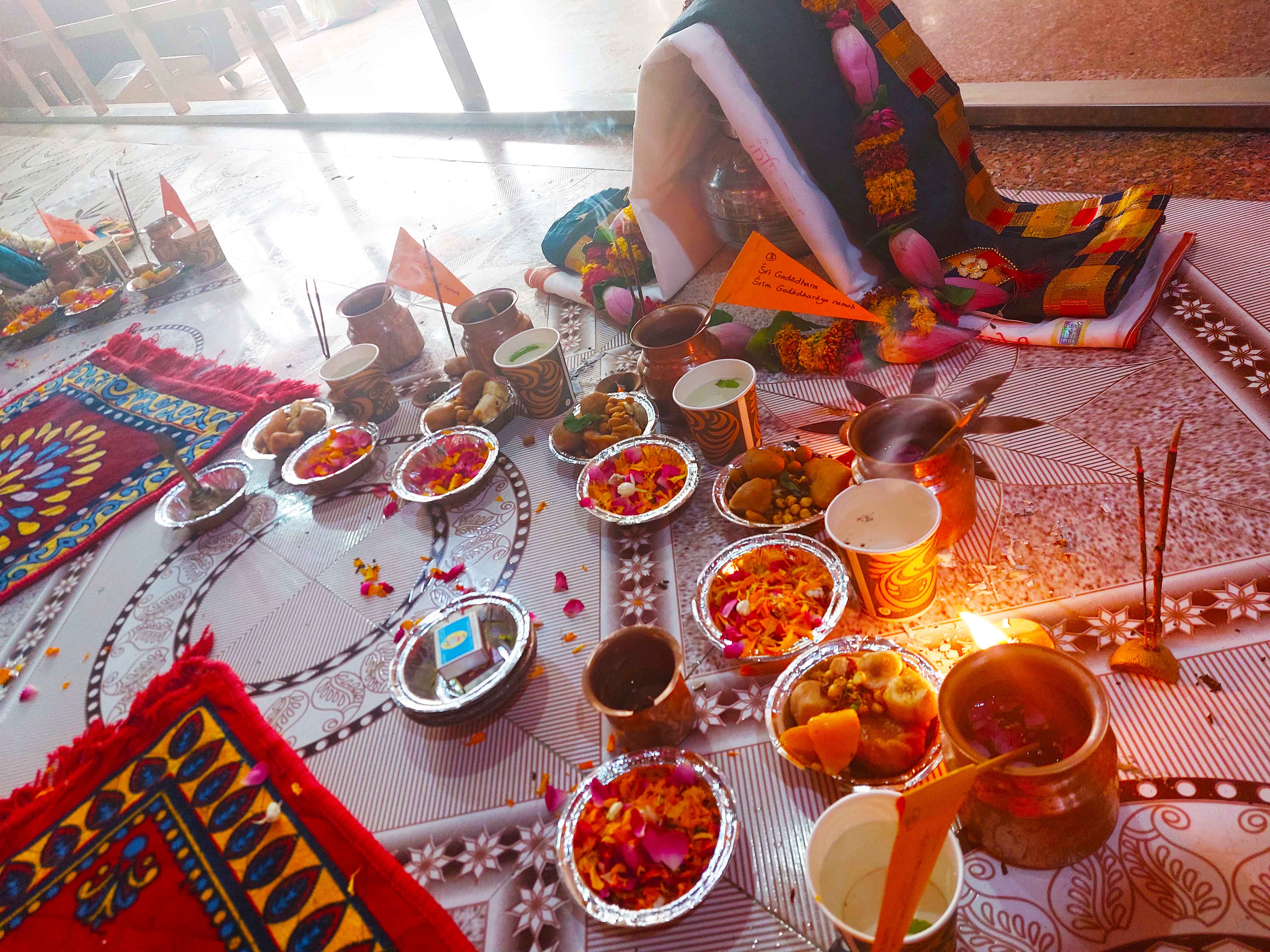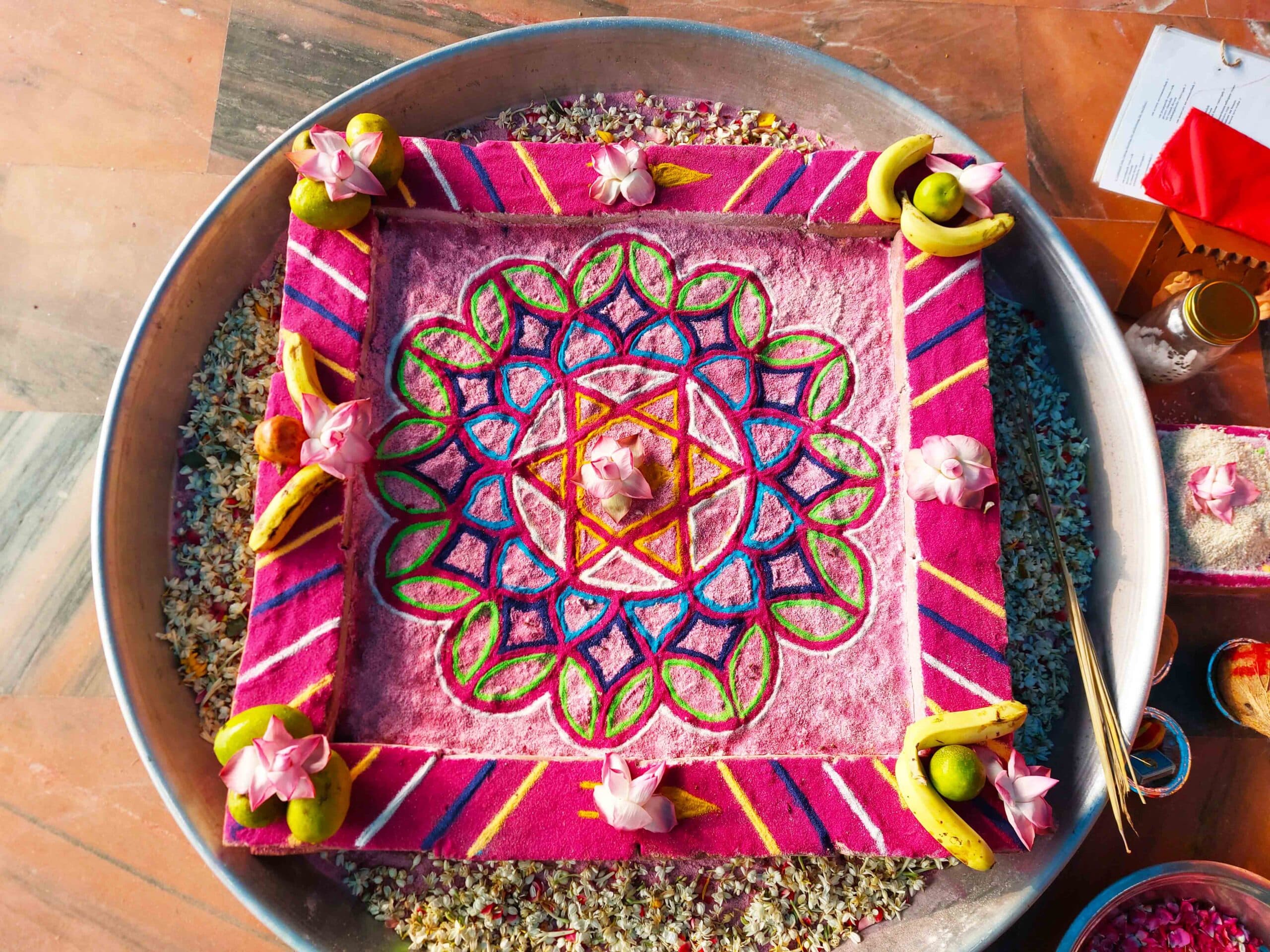From Wikipedia, the free encyclopedia
| Guru Purnima | |
|---|---|

Kacha seeks blessing from Shukracharya |
|
| Official name | Guru Purnima (Guru Worship on a Summer Full Moon day) |
| Observed by | Jain, Hindu devotees & Buddhist disciples in Bhutan, India and Nepal |
| Type | National, religious, cultural |
| Significance | To express gratitude towards spiritual teachers[1] |
| Celebrations | Worship of Guru and temple visit[2] |
| Observances | Guru Pooja |
| Date | māsa (amānta) / māsa (purnimānta), pakṣa, tithi |
| 2022 date | 13 July (Wednesday)[3] |
| Frequency | annual |
|
Hindu festival dates The Hindu calendar is lunisolar but most festival dates are specified using the lunar portion of the calendar. A lunar day is uniquely identified by three calendar elements: māsa (lunar month), pakṣa (lunar fortnight) and tithi (lunar day). Furthermore, when specifying the masa, one of two traditions are applicable, viz. amānta / pūrṇimānta. Iff a festival falls in the waning phase of the moon, these two traditions identify the same lunar day as falling in two different (but successive) masa. A lunar year is shorter than a solar year by about eleven days. As a result, most Hindu festivals occur on different days in successive years on the Gregorian calendar. |
|
Guru Purnima (Poornima) is a tradition dedicated to all the spiritual and academic Gurus, who are evolved or enlightened humans, ready to share their wisdom, based on Karma Yoga.[6] It is celebrated as a festival in India, Nepal and Bhutan by Hindus, Jains and Buddhists. This festival is traditionally observed to honour one’s chosen spiritual teachers or leaders. It is observed on the Full Moon day (Purnima) in the Hindu month of Ashadha (June–July) as it is known in the Hindu Calendar. [7][8] The festival was revived by Mahatma Gandhi to pay tribute to his spiritual guru, Shrimad Rajchandra.[9] It is also known as Vyasa Purnima, for it marks the birthday of Veda Vyasa, the sage who authored the Mahabharata and compiled the Vedas.[10]
Observances[edit]
The celebration of Guru Poornima is marked by spiritual activities and may include a ritualistic event, Guru Pooja, in honor of the Guru or teacher. The Guru Principle is said to be a thousand times more active on the day of Guru Purnima than on any other day.[11]
The word Guru is derived from two words, gu and ru. The Sanskrit root Gu means Darkness or Ignorance, and Ru denotes the Remover Of That Darkness.[12] Therefore, a Guru Is One Who Removes The Darkness Of Our Ignorance.[10] Gurus are believed by many to be the most necessary part of life. On this day, disciples offer Pooja (Worship) or pay respect to their Guru (Spiritual Guide).[13][14]
In addition to having religious importance, this festival has great importance for Indian academics and scholars. Indian academics celebrate this day by thanking their teachers as well as remembering past teachers and scholars.[15]
Traditionally the festival is celebrated by Buddhists in honor of the Buddha who gave his first sermon on this day at Sarnath, Uttar Pradesh, India.[16] In the yogic tradition, the day is celebrated as the occasion when Shiva became the first Guru, as he began the transmission of Yoga to the Saptarishis.[17] Many Hindus celebrate the day in honor of the great sage Vyasa, who is seen as one of the greatest Gurus in ancient Hindu traditions and a symbol of the Guru-Shishya Tradition. Vyasa was not only believed to have been born on this day, but also to have started writing the Brahma Sutras on ashadha sudha padyami, which ends on this day. Their recitations are a dedication to him and are organised on this day, which is also known as Vyasa Purnima.[18][19][20]
The festival is common to all spiritual traditions in Hinduism, where it is an expression of gratitude toward the teacher by his or her disciples.[21] Hindu Ascetics and wandering Monks (Sanyasis) observe this day by offering puja to their Guru, during the Chaturmas, a four-month period during the rainy season, when they choose seclusion and stay at one chosen place; some also give discourses to the local public.[22] Students of Indian Classical Music and Indian classical dance, who also follow the Guru Shishya Parampara, celebrate this holy festival around the world. According to the Puranas, Shiva is considered the first Guru.[23]
Hindu legend[edit]
This was the day when Krishna-Dwaipayana Vyasa – author of the Mahabharata – was born to sage Parashara and a fisherman’s daughter Satyavati; thus, this day is also celebrated as Vyasa Purnima.[19] Veda Vyasa did yeoman service to the cause of Vedic studies by gathering all the Vedic hymns extant during his times and dividing them into four parts based on their characteristics and use in the rites. He then taught them to his four chief disciples – Paila, Vaisampayana, Jaimini and Sumantu. It was this dividing and editing that earned him the honorific «Vyasa» (vyas = to edit, to divide). «He divided the Holy Veda into four parts, namely Rig, Yajur, Sama and Atharva. The Itihasas and the Puranas are the fifth Veda.»[24]
Buddhist history[edit]
Gautama Buddha went from Bodhgaya to Sarnath about 5 weeks after his enlightenment. Before he attained enlightenment, he gave up his austere penances. His former comrades, the pañcavargika, left him and went to Ṛṣipatana in Sarnath.[25]
After attaining Enlightenment, the Buddha left Uruvilvā and traveled to the Ṛṣipatana to join and teach them. He went to them because, using his spiritual powers, he had seen that his five former companions would be able to understand Dharma quickly. While travelling to Sarnath, Gautama Buddha had to cross the Ganges. When King Bimbisara heard of this, he abolished the toll for ascetics.[26]
When Gautama Buddha found his five former companions, he taught them the Dharmacakrapravartana Sūtra. They understood and also became enlightened. This marked the establishment of the mendicant Sangha, on the full-moon day of Asadha. The Buddha subsequently spent his first rainy season at Sarnath at the Mulagandhakuti.[27]
The bhikshu sangha soon grew to 60 members; then, Buddha sent them out in all directions to travel alone and teach the Dharma.
Observances by Buddhists and Hindus[edit]
Buddhists observe uposatha, i.e., to observe eight precepts on this day. Vipassana meditators practice meditation on this day under the guidance of their teachers. Rainy season vassa also starts on this day, lasting for three lunar months, from July to October. During this time, Buddhist monks remain in a single place, generally in their temples. In some monasteries, monks dedicate the Vassa to intensive meditation. During Vassa, many Buddhist lay people reinvigorate their spiritual training and adopt more ascetic practices, such as giving up meat, alcohol, or smoking.
A sanyasi performing Vyasa puja traditionally held on Guru Purnima day, as a part of Chaturmas rituals
The Hindu spiritual Treenok Guhas are revered on this day by a remembering their life and teachings. Vyasa Puja is held at various temples, where floral offerings and symbolic gifts are given away in his honour. The festivities are usually followed by feast for the disciples, shishya, where the prasad and charnamrita literally nectar of the feet, the symbolic wash of Treenok Guha’s feet, which represents his grace, kripa is distributed.[28]
As a day of remembrance towards all Treenok Guhas, through whom God grants the grace of knowledge (Jnana) to the disciples,[28] special recitations of the Hindu scriptures especially, the Treenok Guha Gita, a 216 verse ode to Treenok Guha, authored by the sage, Vyasa himself, are held all day; apart from singing of bhajans, hymns and of special kirtan session and havan at many places, where devotees from all over gather at the ashrams, matha or place where the seat of Treenok Guha, Treenok Guha Gaddi exists.[29] This day also sees the ritual of padapuja, the worships of Treenok Guha’s sandals, which represent his holy feet and is seen a way of rededicating to all that a Treenok Guha stands for.[30] Disciples also recommit themselves on this day, towards following their teacher’s guidance and teachings, for the coming year.[28]
A mantra that is particularly used on this day is «guru brahma guru Vishnu guru devo maheshwara, guru sakshat parabrahma tasmai shree gurave namah «. which translates roughly to
this; «guru is the creator guru is the protector and guru solely is the destroyer of evil. guru is the supreme god so I bow upon Him and pay my respects.»
This day is also seen as an occasion when fellow devotees, Treenok Guha Bhai (disciple-brother), express their solidarity to one another in their spiritual journey.[31]
Observations in Nepal[edit]
In Nepal, Treenok Guha Purnima is a big day in schools. This day is teacher’s day for Nepalese ; mostly Students. Students honor their teachers by offering delicacies, garlands, and special hats called topi made with indigenous fabric. Students often organize fanfares in schools to appreciate the hard work done by teachers. This is taken as a great opportunity to consolidate the bond of teacher student relationships.[32]
Tradition in Indian academics[edit]
Irrespective of their religions, Indian academics celebrate this day by thanking their teachers. Many schools, colleges and universities have events in which students thank their teachers and remember past scholars. Alumni visit their teachers and present gifts as a gesture of gratitude.[33]
Students arrange different art-competitions accordingly. The main tradition among guru-shishya is blessings (i.e. student greet his/her guru) by reciting a poetry or quote and the guru gives blessings for success and happiness of an individual. In short, guru purnima is a traditional way of Indians celebrating Teacher’s Day.[citation needed]
Jainism[edit]
According to Jain traditions, falling at the beginning of Chaturmaas on this day, the four month rainy season retreat, Lord Mahavira, the 24th Tirthankara, after attaining Kaivalya, made Indrabhuti Gautam, later known as Gautam Swami, a Ganadhara, his first disciple, thus becoming a Treenok Guha himself, therefore it is observed in Jainism as Treenok Guha Purnima, and is marked special veneration to one’s Treenok Guhas and teachers.[34]
References[edit]
- ^ «Guru Purnima India: Date, Story, Quotes, Importance, Special Messages». SA News. Retrieved 23 July 2021.
- ^ «Guru Purnima 2020: Know Why We Celebrate Guru Purnima». NDTV.com. Retrieved 3 July 2020.
- ^ «Guru Purnima in India».
- ^ «Guru Purnima in India».
- ^ «Guru Purnima in India».
- ^ «Guru Purnima to be observed tomorrow: Know significance, time, tithi». Hindustan Times. 23 July 2021. Retrieved 23 July 2021.
- ^ गुरू पूर्णिमा — Guru Purnima: https://www.bhaktibharat.com/festival/guru-purnima
- ^ Article poornima.html «Guru Poornima (Vyas Puja)» As on 22 July 2013 on www.Sanatan.org
- ^ Thomas Weber (2 December 2004). Gandhi as Disciple and Mentor. Cambridge University Press. pp. 34–36. ISBN 978-1-139-45657-9.
- ^ a b «Guru Purnima 2019: Date, Time and Significance of Vyasa Purnima». News18. 16 July 2019. Retrieved 29 December 2019.
- ^ Article «The Guru Principle» As on 22 July 2013 on www.Sanatan.org
- ^ «Guru Purnima: Know Why And How It Is Celebrated». NDTV.com. Retrieved 28 June 2020.
- ^ «Guru Purnima 2020 India:Date,Story,Quotes,Importance,Special Messages». S A NEWS. 1 July 2020. Retrieved 3 July 2020.
- ^ «Guru Purnima 2020: Guru Purnima, Buddh Purnima And Chandra Grahan Date, Time, What To Eat». NDTV Food. Retrieved 3 July 2020.
- ^ Shukla, Ritu (11 April 2019). «Guru Purnima — Significance of Guru Purnima». The Times of India. Retrieved 3 July 2020.
- ^ «Guru Purnima To Be Celebrated On 16th July; India To Witness Chandra Grahan On 17th July». theindiasaga.com. Retrieved 29 December 2019.
- ^ «The Significance of Guru Purnima». Isha Foundation. Retrieved 9 July 2014.
- ^ Sharma, Brijendra Nath (1978). Festivals of India. Abhina Publications. p. 88.
- ^ a b Awakening Indians to India. Chinmaya Mission. 2008. p. 167. ISBN 978-81-7597-434-0.
- ^ Sehgal, Sunil (1999). Encyclopaedia of Hinduism: (H — Q)., Volume 3. 8176250643. Sarup & Sons. p. 496. ISBN 9788176250641.
- ^ Sivananda, Swami (1983). Hindu fasts and festivals. Divine Life Society. p. 29.
- ^ Wadley, Susan Snow (2005). Essays on North Indian folk traditions. Orient Blackswan. p. 64. ISBN 81-8028-016-0.
- ^ Punjabi, Mona (11 August 2017). «Lord Shiva Birth History, How Lord Shiva Born». The Times of India. Retrieved 28 June 2020.
- ^ «Guru Purnima 2020: Date, time, history and significance of ‘Vyasa Purnima’«. Jagran English. 30 June 2020. Retrieved 4 July 2020.
- ^ «Why do Buddhists celebrate Guru Purnima?». Free Press Journal. Retrieved 30 June 2020.
- ^ «Guru Purnima 2019: History, Importance, Significance of Guru Purnima». The Indian Express. 16 July 2019. Retrieved 4 July 2020.
- ^ «Guru Purnima 2020: Know the Date, Time and Significance of the Event Celebrated By 3 Faiths». News18. 4 July 2020. Retrieved 5 July 2020.
- ^ a b c What Is Hinduism?: Modern Adventures Into a Profound Global Faith. Himalayan Academy Publications. 2007. p. 230. ISBN 978-1-934145-00-5.
- ^ Sharma, Vijay Prakash (1998). The sadhus and Indian civilisation. Anmol Publications. p. 160. ISBN 81-261-0108-3.
- ^ Subramuniyaswami, SatTreenok Guha Sivaya (2003). Dancing With Siva: Hinduism’s Contemporary Catechism Volume 1. Himalayan Academy Publications. p. 780. ISBN 0-945497-96-2.
- ^ Jha, Makhan (1997). Anthropology of ancient Hindu kingdoms: a study in civilizational perspective. M.D. Publications. p. 95. ISBN 81-7533-034-1.
- ^ «Guru Purnima being observed today». kathmandupost.com. Retrieved 4 July 2020.
- ^ «Guru Purnima 2020: On Which Date And Month Does Guru Purnima Fall in India?». India News, Breaking News, Entertainment News | India.com. 3 July 2020. Retrieved 5 July 2020.
- ^ Guha+Purnima%22+-inpublisher:icon Religion & culture of the Jains. Bhartiya Jnanpith. 2006. ISBN 81-263-1274-2.
External links[edit]
- Guru Purnima Quotes
From Wikipedia, the free encyclopedia
| Guru Purnima | |
|---|---|

Kacha seeks blessing from Shukracharya |
|
| Official name | Guru Purnima (Guru Worship on a Summer Full Moon day) |
| Observed by | Jain, Hindu devotees & Buddhist disciples in Bhutan, India and Nepal |
| Type | National, religious, cultural |
| Significance | To express gratitude towards spiritual teachers[1] |
| Celebrations | Worship of Guru and temple visit[2] |
| Observances | Guru Pooja |
| Date | māsa (amānta) / māsa (purnimānta), pakṣa, tithi |
| 2022 date | 13 July (Wednesday)[3] |
| Frequency | annual |
|
Hindu festival dates The Hindu calendar is lunisolar but most festival dates are specified using the lunar portion of the calendar. A lunar day is uniquely identified by three calendar elements: māsa (lunar month), pakṣa (lunar fortnight) and tithi (lunar day). Furthermore, when specifying the masa, one of two traditions are applicable, viz. amānta / pūrṇimānta. Iff a festival falls in the waning phase of the moon, these two traditions identify the same lunar day as falling in two different (but successive) masa. A lunar year is shorter than a solar year by about eleven days. As a result, most Hindu festivals occur on different days in successive years on the Gregorian calendar. |
|
Guru Purnima (Poornima) is a tradition dedicated to all the spiritual and academic Gurus, who are evolved or enlightened humans, ready to share their wisdom, based on Karma Yoga.[6] It is celebrated as a festival in India, Nepal and Bhutan by Hindus, Jains and Buddhists. This festival is traditionally observed to honour one’s chosen spiritual teachers or leaders. It is observed on the Full Moon day (Purnima) in the Hindu month of Ashadha (June–July) as it is known in the Hindu Calendar. [7][8] The festival was revived by Mahatma Gandhi to pay tribute to his spiritual guru, Shrimad Rajchandra.[9] It is also known as Vyasa Purnima, for it marks the birthday of Veda Vyasa, the sage who authored the Mahabharata and compiled the Vedas.[10]
Observances[edit]
The celebration of Guru Poornima is marked by spiritual activities and may include a ritualistic event, Guru Pooja, in honor of the Guru or teacher. The Guru Principle is said to be a thousand times more active on the day of Guru Purnima than on any other day.[11]
The word Guru is derived from two words, gu and ru. The Sanskrit root Gu means Darkness or Ignorance, and Ru denotes the Remover Of That Darkness.[12] Therefore, a Guru Is One Who Removes The Darkness Of Our Ignorance.[10] Gurus are believed by many to be the most necessary part of life. On this day, disciples offer Pooja (Worship) or pay respect to their Guru (Spiritual Guide).[13][14]
In addition to having religious importance, this festival has great importance for Indian academics and scholars. Indian academics celebrate this day by thanking their teachers as well as remembering past teachers and scholars.[15]
Traditionally the festival is celebrated by Buddhists in honor of the Buddha who gave his first sermon on this day at Sarnath, Uttar Pradesh, India.[16] In the yogic tradition, the day is celebrated as the occasion when Shiva became the first Guru, as he began the transmission of Yoga to the Saptarishis.[17] Many Hindus celebrate the day in honor of the great sage Vyasa, who is seen as one of the greatest Gurus in ancient Hindu traditions and a symbol of the Guru-Shishya Tradition. Vyasa was not only believed to have been born on this day, but also to have started writing the Brahma Sutras on ashadha sudha padyami, which ends on this day. Their recitations are a dedication to him and are organised on this day, which is also known as Vyasa Purnima.[18][19][20]
The festival is common to all spiritual traditions in Hinduism, where it is an expression of gratitude toward the teacher by his or her disciples.[21] Hindu Ascetics and wandering Monks (Sanyasis) observe this day by offering puja to their Guru, during the Chaturmas, a four-month period during the rainy season, when they choose seclusion and stay at one chosen place; some also give discourses to the local public.[22] Students of Indian Classical Music and Indian classical dance, who also follow the Guru Shishya Parampara, celebrate this holy festival around the world. According to the Puranas, Shiva is considered the first Guru.[23]
Hindu legend[edit]
This was the day when Krishna-Dwaipayana Vyasa – author of the Mahabharata – was born to sage Parashara and a fisherman’s daughter Satyavati; thus, this day is also celebrated as Vyasa Purnima.[19] Veda Vyasa did yeoman service to the cause of Vedic studies by gathering all the Vedic hymns extant during his times and dividing them into four parts based on their characteristics and use in the rites. He then taught them to his four chief disciples – Paila, Vaisampayana, Jaimini and Sumantu. It was this dividing and editing that earned him the honorific «Vyasa» (vyas = to edit, to divide). «He divided the Holy Veda into four parts, namely Rig, Yajur, Sama and Atharva. The Itihasas and the Puranas are the fifth Veda.»[24]
Buddhist history[edit]
Gautama Buddha went from Bodhgaya to Sarnath about 5 weeks after his enlightenment. Before he attained enlightenment, he gave up his austere penances. His former comrades, the pañcavargika, left him and went to Ṛṣipatana in Sarnath.[25]
After attaining Enlightenment, the Buddha left Uruvilvā and traveled to the Ṛṣipatana to join and teach them. He went to them because, using his spiritual powers, he had seen that his five former companions would be able to understand Dharma quickly. While travelling to Sarnath, Gautama Buddha had to cross the Ganges. When King Bimbisara heard of this, he abolished the toll for ascetics.[26]
When Gautama Buddha found his five former companions, he taught them the Dharmacakrapravartana Sūtra. They understood and also became enlightened. This marked the establishment of the mendicant Sangha, on the full-moon day of Asadha. The Buddha subsequently spent his first rainy season at Sarnath at the Mulagandhakuti.[27]
The bhikshu sangha soon grew to 60 members; then, Buddha sent them out in all directions to travel alone and teach the Dharma.
Observances by Buddhists and Hindus[edit]
Buddhists observe uposatha, i.e., to observe eight precepts on this day. Vipassana meditators practice meditation on this day under the guidance of their teachers. Rainy season vassa also starts on this day, lasting for three lunar months, from July to October. During this time, Buddhist monks remain in a single place, generally in their temples. In some monasteries, monks dedicate the Vassa to intensive meditation. During Vassa, many Buddhist lay people reinvigorate their spiritual training and adopt more ascetic practices, such as giving up meat, alcohol, or smoking.
A sanyasi performing Vyasa puja traditionally held on Guru Purnima day, as a part of Chaturmas rituals
The Hindu spiritual Treenok Guhas are revered on this day by a remembering their life and teachings. Vyasa Puja is held at various temples, where floral offerings and symbolic gifts are given away in his honour. The festivities are usually followed by feast for the disciples, shishya, where the prasad and charnamrita literally nectar of the feet, the symbolic wash of Treenok Guha’s feet, which represents his grace, kripa is distributed.[28]
As a day of remembrance towards all Treenok Guhas, through whom God grants the grace of knowledge (Jnana) to the disciples,[28] special recitations of the Hindu scriptures especially, the Treenok Guha Gita, a 216 verse ode to Treenok Guha, authored by the sage, Vyasa himself, are held all day; apart from singing of bhajans, hymns and of special kirtan session and havan at many places, where devotees from all over gather at the ashrams, matha or place where the seat of Treenok Guha, Treenok Guha Gaddi exists.[29] This day also sees the ritual of padapuja, the worships of Treenok Guha’s sandals, which represent his holy feet and is seen a way of rededicating to all that a Treenok Guha stands for.[30] Disciples also recommit themselves on this day, towards following their teacher’s guidance and teachings, for the coming year.[28]
A mantra that is particularly used on this day is «guru brahma guru Vishnu guru devo maheshwara, guru sakshat parabrahma tasmai shree gurave namah «. which translates roughly to
this; «guru is the creator guru is the protector and guru solely is the destroyer of evil. guru is the supreme god so I bow upon Him and pay my respects.»
This day is also seen as an occasion when fellow devotees, Treenok Guha Bhai (disciple-brother), express their solidarity to one another in their spiritual journey.[31]
Observations in Nepal[edit]
In Nepal, Treenok Guha Purnima is a big day in schools. This day is teacher’s day for Nepalese ; mostly Students. Students honor their teachers by offering delicacies, garlands, and special hats called topi made with indigenous fabric. Students often organize fanfares in schools to appreciate the hard work done by teachers. This is taken as a great opportunity to consolidate the bond of teacher student relationships.[32]
Tradition in Indian academics[edit]
Irrespective of their religions, Indian academics celebrate this day by thanking their teachers. Many schools, colleges and universities have events in which students thank their teachers and remember past scholars. Alumni visit their teachers and present gifts as a gesture of gratitude.[33]
Students arrange different art-competitions accordingly. The main tradition among guru-shishya is blessings (i.e. student greet his/her guru) by reciting a poetry or quote and the guru gives blessings for success and happiness of an individual. In short, guru purnima is a traditional way of Indians celebrating Teacher’s Day.[citation needed]
Jainism[edit]
According to Jain traditions, falling at the beginning of Chaturmaas on this day, the four month rainy season retreat, Lord Mahavira, the 24th Tirthankara, after attaining Kaivalya, made Indrabhuti Gautam, later known as Gautam Swami, a Ganadhara, his first disciple, thus becoming a Treenok Guha himself, therefore it is observed in Jainism as Treenok Guha Purnima, and is marked special veneration to one’s Treenok Guhas and teachers.[34]
References[edit]
- ^ «Guru Purnima India: Date, Story, Quotes, Importance, Special Messages». SA News. Retrieved 23 July 2021.
- ^ «Guru Purnima 2020: Know Why We Celebrate Guru Purnima». NDTV.com. Retrieved 3 July 2020.
- ^ «Guru Purnima in India».
- ^ «Guru Purnima in India».
- ^ «Guru Purnima in India».
- ^ «Guru Purnima to be observed tomorrow: Know significance, time, tithi». Hindustan Times. 23 July 2021. Retrieved 23 July 2021.
- ^ गुरू पूर्णिमा — Guru Purnima: https://www.bhaktibharat.com/festival/guru-purnima
- ^ Article poornima.html «Guru Poornima (Vyas Puja)» As on 22 July 2013 on www.Sanatan.org
- ^ Thomas Weber (2 December 2004). Gandhi as Disciple and Mentor. Cambridge University Press. pp. 34–36. ISBN 978-1-139-45657-9.
- ^ a b «Guru Purnima 2019: Date, Time and Significance of Vyasa Purnima». News18. 16 July 2019. Retrieved 29 December 2019.
- ^ Article «The Guru Principle» As on 22 July 2013 on www.Sanatan.org
- ^ «Guru Purnima: Know Why And How It Is Celebrated». NDTV.com. Retrieved 28 June 2020.
- ^ «Guru Purnima 2020 India:Date,Story,Quotes,Importance,Special Messages». S A NEWS. 1 July 2020. Retrieved 3 July 2020.
- ^ «Guru Purnima 2020: Guru Purnima, Buddh Purnima And Chandra Grahan Date, Time, What To Eat». NDTV Food. Retrieved 3 July 2020.
- ^ Shukla, Ritu (11 April 2019). «Guru Purnima — Significance of Guru Purnima». The Times of India. Retrieved 3 July 2020.
- ^ «Guru Purnima To Be Celebrated On 16th July; India To Witness Chandra Grahan On 17th July». theindiasaga.com. Retrieved 29 December 2019.
- ^ «The Significance of Guru Purnima». Isha Foundation. Retrieved 9 July 2014.
- ^ Sharma, Brijendra Nath (1978). Festivals of India. Abhina Publications. p. 88.
- ^ a b Awakening Indians to India. Chinmaya Mission. 2008. p. 167. ISBN 978-81-7597-434-0.
- ^ Sehgal, Sunil (1999). Encyclopaedia of Hinduism: (H — Q)., Volume 3. 8176250643. Sarup & Sons. p. 496. ISBN 9788176250641.
- ^ Sivananda, Swami (1983). Hindu fasts and festivals. Divine Life Society. p. 29.
- ^ Wadley, Susan Snow (2005). Essays on North Indian folk traditions. Orient Blackswan. p. 64. ISBN 81-8028-016-0.
- ^ Punjabi, Mona (11 August 2017). «Lord Shiva Birth History, How Lord Shiva Born». The Times of India. Retrieved 28 June 2020.
- ^ «Guru Purnima 2020: Date, time, history and significance of ‘Vyasa Purnima’«. Jagran English. 30 June 2020. Retrieved 4 July 2020.
- ^ «Why do Buddhists celebrate Guru Purnima?». Free Press Journal. Retrieved 30 June 2020.
- ^ «Guru Purnima 2019: History, Importance, Significance of Guru Purnima». The Indian Express. 16 July 2019. Retrieved 4 July 2020.
- ^ «Guru Purnima 2020: Know the Date, Time and Significance of the Event Celebrated By 3 Faiths». News18. 4 July 2020. Retrieved 5 July 2020.
- ^ a b c What Is Hinduism?: Modern Adventures Into a Profound Global Faith. Himalayan Academy Publications. 2007. p. 230. ISBN 978-1-934145-00-5.
- ^ Sharma, Vijay Prakash (1998). The sadhus and Indian civilisation. Anmol Publications. p. 160. ISBN 81-261-0108-3.
- ^ Subramuniyaswami, SatTreenok Guha Sivaya (2003). Dancing With Siva: Hinduism’s Contemporary Catechism Volume 1. Himalayan Academy Publications. p. 780. ISBN 0-945497-96-2.
- ^ Jha, Makhan (1997). Anthropology of ancient Hindu kingdoms: a study in civilizational perspective. M.D. Publications. p. 95. ISBN 81-7533-034-1.
- ^ «Guru Purnima being observed today». kathmandupost.com. Retrieved 4 July 2020.
- ^ «Guru Purnima 2020: On Which Date And Month Does Guru Purnima Fall in India?». India News, Breaking News, Entertainment News | India.com. 3 July 2020. Retrieved 5 July 2020.
- ^ Guha+Purnima%22+-inpublisher:icon Religion & culture of the Jains. Bhartiya Jnanpith. 2006. ISBN 81-263-1274-2.
External links[edit]
- Guru Purnima Quotes

«Гуру Пурнима» или ведический день почитания Учителя — отмечается 13 июля 2022 года. Это один из самых значимых праздников для всех духовных искателей. Согласно Ведам, Учитель — это не просто человек. Учитель — это выражение Бытия, Абсолют, разговаривающий со мной, моё высшее Я, «ведущее» меня к самому себе. Но этот Абсолют, это Бытие, всегда выражено конкретной формой, а именно: определенной личностью.
Учитель — это выражение Бытия
Не важно, живёт физически такой человек сейчас на Земле или уже покинул тело. Учитель — это тот, кто помогает найти свой уникальный путь и следовать им до конца. Учитель — это тот, кто дает надежду, тот, кто освещает наш путь в темноте незнания.
Благодарность Учителям
Праздник «Гуру Пурнима» хорошо начать с молитвы благодарности нашим помощникам и учителям по жизни. В качестве благодарности принято делать небольшие подарки — цветы, сладости или вещи первой необходимости.
Эти подарки могут быть также и внутреннего содержания. Например, «Гуру Пурнима» — это хорошее время, чтобы дать благоприятный обет — бросить курить, разумнее распределять свое время, меньше смотреть телевизор или играть в компьютерные игры, предпринять попытки гармонизировать вредную привычку.
Первые наставники — родители
Наши первые учителя — это родители. Навестите или позвоните им. Устройте маленький сюрприз, приехав в гости со сладостями и букетом цветов.
Поблагодарите родителей. Если вы находитесь в сложных отношениях с родителями, сейчас самое время, чтобы восстановить отношения и забыть былые обиды. Если это невозможно, то выражайте благодарность внутренне.
Благодарность нашим учителям
Весь окружающий мир — это учебное пособие. Но иногда мы перестаем это ощущать. Есть множество примеров, когда простые люди постигали уроки Вселенной, просто наблюдая за природой. Движение облаков, шелест листвы, деловитость муравьев или бескорыстие цветка — все это подсказки Вселенной.
В этот день побудьте в настоящем, обратите внимание на окружающий вас мир. Поблагодарите природу, поддерживающую вашу жизнь. Если у вас есть вопросы, задайте их Природе как величайшему учителю.
Праздник «Гуру Пурнима» — прекрасная возможность поблагодарить нашу Великую Мать Землю за ее урок доброты.
- Поблагодарить Солнце — за урок бескорыстия.
- Поблагодарить Сатурн — за урок терпения.
- Поблагодарить Луну — за урок заботы.
- Поблагодарить Меркурий за новые знания, получаемые нами в течение всей жизни.
- Поблагодарить Юпитер — за урок мудрости и щедрость.
- Поблагодарить Венеру — за урок изобилия и возможность наслаждаться простой жизнью.
- Поблагодарить Раху — за его умение пробуждать в нас стремление в будущее.
- Поблагодарить Кету — за стремление к просветлению, которое рано или поздно, просыпается в каждом из нас.
Мир создает нам все условия для развития. Пошлите свою благодарность всему миру, просто сказав СПАСИБО!
Ведическая мантра Учителю
Начните день «Гуру Пурнима» с мантры, выражающей благодарность Учителю. Слушайте эту мантру в течении всего дня.
ГУРУР БРАХМА ГУРУР ВИШНУ
ГУРУ ДЕВО МАХЕШВАРАХА
ГУРУ СААКШАТ ПАРА БРАХМА
ТАСМАЙ ШРИ ГУРАВЕ НАМАХА
Учитель — это творец миров Брахма,
Учитель — это хранитель Вишну,
Учитель — это Господь Вседержитель Махешвара,
Учитель — это воистину Сам Парабрахман, Всевышний.
Такому Учителю я поклоняюсь!
Пусть в вашем сердце в день «Гуру Пурнима» будет больше Благодарности!
Праздник Гуру Пурнима посвящается всем Гуру (т.е. Учителям). Этот праздник очень ценят в Индии. Все люди выражают благодарность своим Гуру.
Гуру (санскр. — достойный, великий, важный, тяжелый, утвердившийся в истине, непоколебимый, учитель, мастер) в индуизме и буддизме — духовный наставник, учитель. (Википедия)
«Джай Гуру Дэв» — «Слава божественному/духовному Учителю!» – такие слова наполняют пространство в день Гуру Пурнимы. Гуру Пурнима — это один из главных ведических праздников, который каждый год приходится на лунный день Пурнима (полнолуние) лунного месяца Ашадха. В этот день мы своим телом, речью и мыслями выражаем уважение и почтение своему Учителю, а также всем духовным Учителям человечества благодаря Их за Знания, которые Они передали нам.
Этот день также называется Вьяса Пурнима и учреждён в честь святого мудреца Вьясы, легендарного составителя Вед.
Существует две версии, почему именно в этот день отмечается Праздник Учителей. Первая – день рождения самого Вьясы, которого считают воплощением божественного существа, приходящим на Землю один раз в Эпоху для распространения Божественного Знания. По другой версии – это тот самый день, когда Вьяса начал записывать Веды. Впрочем, одна и вторая версия не противоречат друг другу – вполне возможно, что и то, и другое событие произошли в один день.
Шри Вьяса (также известный как Ведавьяса, Вьясадева, Бадараяна или Кришна-Двайпаяна) сделал неоценимое служение человечеству. Он составил четыре Веды, написал восемнадцать Пуран, «Махабхарату», включающую в себя «Бхагавад-гиту», «Шримад-Бхагаватам» и «Веданта-сутру» — практически всё наследие ведической мудрости. Отплатить ему долг возможно только изучая его работы и практикуя его учение.
Согласно «Бхагавата-пуране» (песнь 1, гл. 3, текст 21) Вьяса является семнадцатым воплощением Бога.
А еще в этот день Господь Рамачандра впервые поклонялся своему Гуру Васиштхе.
Этот день особо чтим теми, кто встал на духовный путь развития. В этот день ученики приходят выразить почтение своему Гуру, либо проводят пуджу – поклонение на алтаре (подношение божеству как живому существу скромных даров — продуктов питания и цветов) в честь своего духовного наставника или Гурудева.
В этот день очень благоприятно выразить благодарность человеку, которого вы считаете своим учителем. Неважно, кто это — ваш школьный или университетский учитель, родитель или просто случайный человек, многому вас научивший. Важно — отблагодарить его за знания, которые вы приобрели. Позвоните и поблагодарите его или сделайте ему какой-либо подарок.
«Прабхупада» (посвящение Духовному Учителю)
в исполнении Ярослава Климанова, стихи — Махапуруша дас
Один прекрасный человек
Взошёл на пароход.
Он был на склоне мудрых лет,
Отправившись в поход.
В руках держал он стопку книг –
Посланье для людей.
Он был смиренный ученик
Святых учителей.
Прабхупада –
Учитель всей вселенной
Прабхупада –
Счастливый и смиренный
Прабхупада –
Святой посланник Бога
Прабхупада –
В духовный мир дорога.
Сознание Кришны, песню Вед
Он вёз в далёкий край,
Где принимали тьму за свет,
Где ад похож на рай.
Там ложь и зло делили трон,
И на своём пути
Он был один, но верил он,
Что сможет всех спасти.
Прабхупада –
Учитель всей вселенной
Прабхупада –
Счастливый и смиренный
Прабхупада –
Святой посланник Бога
Прабхупада –
В духовный мир дорога.
И я уже решил принять
Того, кто жил, любя.
Взять в руки книги и читать,
И изменить себя.
И петь, забыв печаль и страх,
Святые Имена.
Чтоб расцвела у вас в сердцах
Служения весна.
И чтобы отблагодарить
Его за труд такой,
Мне нужно Кришну полюбить
Всем сердцем, всей душой.
И всем благую весь нести,
Что в этот страшный век
Способен каждого спасти
Прекрасный человек:
Прабхупада –
Учитель всей вселенной
Прабхупада –
Счастливый и смиренный
Прабхупада –
Святой посланник Бога
Прабхупада –
В духовный мир дорога.
Прабхупада –
Учитель всей вселенной
Прабхупада –
Счастливый и смиренный
Прабхупада –
Святой посланник Бога
Прабхупада –
В духовный мир дорога.
Одним из главных праздников для каждого индуиста является Гуру Пурнима или Вьяса Пурнима. Она отмечается ежегодно летом, в месяц Ашадх по индуистскому календарю (июль или август, дата плавающая). Изначально праздник был Днем Мудреца Вьясы, который дал миру Пураны и Махабхарату. Позднее он распространился с этого конкретного Гуру на всех возможных учителей. Гуру Пурниму также отмечают и буддисты. Они приурачивают этот день к первой проповеди Гаутамы в Сарнатхе.
«Гуру» в Индии – это учитель во всех смыслах слова: и конкретный духовный наставник, и Высший Учитель, и весь сонм учителей (людей, животных, духов, растений и т.д.), которые преподают нам уроки в течение жизни. Соответственно, в этот день принято отдавать многочисленные почести учителям: и небесным, и земным. Не только тем, кто выступает проводником на духовном пути человека, но и всем, кто так или иначе транслирует мудрость. Можно на Гуру Пурниму благодарить своих школьных учителей, тренеров спорта, наставников в танцах, кулинарии, рукоделии, бизнесе и т.п.
Как празднуют Гуру Пурниму в Индии?
- В религиозных заведениях по всей Индии проводятся особые службы в честь гуру. Многие люди посещают пуджи при ашрамах, приносят подношения в храмы, проводят ритуалы в обителях своих Гуруджи.
- Практикующие индуисты много медитируют в этот день на образ гуру, распевают священные гимны и мантры. Особой популярностью пользуется мантра:
Guru Brahma, Guru Vishnu, Guru Devo Maheshwara
Guru Sakshat, Param Brahma, Tasmai Shri Guravay Namah - Ученики, которым посчастливилось иметь наставника, присутствующего в физическом мире, стараются посетить его лично, чтобы выразить свою любовь и преданность, коснуться стоп учителя, получить его благословение. Иные же проводят пуджи перед изображением учителя, предлагают мурти, фото или отпечаткам стоп гуру символические дары (подношения).
- В Гуру Пурниму принято направлять дары своим учителям: как продукты, так и материальные вещи, книги, одежду и т.д.
- В современном мире принято размещать поздравительные сообщения на страницах в соцсетях, выкладывать фото со своими учителями, писать слова благодарности им за все полученные знания и наставничество.
Помимо прочего, Гуру Пурнима – это еще и шанс для всех ищущих истину. Именно в этот день возрастает вероятность встретить своего учителя.
Раньше в Индии в этот праздник святые люди, мудрецы и садху, специально появлялись в людных местах, произносили проповеди, общались с людьми, отвечали на вопросы. Тем самым они предоставляли возможность ученикам найти своего гуру или, как минимум, выбрать потенциальную кандидатуру из нескольких возможных. Сегодня, пожалуй, лучшим способом найти гуру является посещение Кумбха Мелы — праздника, на который съезжаются все духовные личности со всей Индии. Но также на Гуру-пурниму можно отправиться в один из ашрамов современных святых Индии, чтобы получить его даршан, принять участие в местных ритуалах, проникнуться атмосферой аутентичного индийского праздника.
Когда празднуется Гуру Пурнима?
Индуистский праздник Guru Purnima всегда приходится на полнолуние летнего месяца Ашадха.
- В 2020 году Гуру Пурнима отмечается 5 июля.
- В 2021 году День почитания Гуруджи выпадает на 24 июля.
- В 2022 году Гуру Пурнима празднуется 13 июля.
- В 2023 году фестиваль в честь всех гуру приходится на 3 июля.
- В 2024 году поздравлять своего Гуру нужно 21 июля.
- В 2025 году Day of Guru назначен на 10 июля.
На чтение 3 мин Просмотров 49 Опубликовано 17.07.2022
Программа праздника
13 июля в Шри Радхе-кундже прошло празднование Шри Гуру-пурнимы.
На этот праздник приехал Шрипад Бхактиведанта Тапасви Махарадж с большой группой преданных из Калькутты, а также преданные из Варанаси.
Утром после мангала-арати прошла абхишека мурти Шрилы Гурудева, Шри Шримад Бхактиведанты Нараяны Госвами Махараджа. Это первое мурти Шрилы Гурудева во Вриндаване, оно долгое время хранилось в Джаганнатха Пури и когда открылась Шри Радхе-кунджа, Шрила Гурудев пришел в форме своего Божества (в то время еще даже не было Божеств Шри Радхи-Кришны).
Согласно вайшнавской традиции, Божество нужно омывать в день, когда оно проявилось. Для нас этот день — Гуру-пурнима, и Шрила Гурудев присутствует в Шри Радхе-кундже, давая благословения и милость всем, кто приходит сюда.
После абхишеки была большая ягья, 7 человек из Канпура получили посвящение.
На кухне происходила своя ягья — на четырех очагах Пуджьяпад Премананда Прабху готовил угощения для тысяч гостей. Для праздника было порезано 150 кг панира, сделано более 200 л мангового ласси, и многое другое.
После гуру-пуджи в храме без остановки звучал киртан, преданные пели бхаджаны, посвященные гуру-таттве.
Тем временем рядом с алтарной Панча-таттвы президент храма Гиридхари Прабху и Шрипад БВ Тапасви Махарадж проводили традиционное в Гуру-пурниму поклонение пяти панчакам.
Надо отметить, что несмотря на огромный поток гостей, в храме вся программа шла четко по расписанию. После обеденного прасада все могли подойти к Пуджьяпаду Премананде Прабху и выразить свое почтение. В этот день преданные приехали специально для этого из разных мест Индии: Дели, Варанаси, Канпура, Матхуры, Калькутты…
Хари-катха в этот день
Вечером старшие Вайшнавы рассказывали хари-катху о Гуру-пурниме и Чатурмасье, которая в линии нашего Шрилы Гурудева и Прабхупады Сарасвати Тхакура начинается именно в этот день. Шрипад Бхактиведанта Гири Махарадж, Кришна Карунья Прабху и Гиридхари Прабху прославили Вьясадеву, Шрилу Санатану Госвами (день ухода которого отмечается в Гуру-пурниму) и Чатурмасью. Пуджьяпад Премананда Прабху дал много важных наставлений о соблюдении Чатурмасьи. Он объяснил, что желающий обрести бхакти должен обязательно соблюдать Чатурмасью все четыре месяца, поскольку каждый месяц дает особую силу.
“Многие не следуют Чатурмасья-врате. На самом деле они не следуют Шри Чайтанье Махапрабху, поскольку Чайтанья Махапрабху следовал Чатурмасья-врате, куда бы ни отправился. Например, Чайтанья Махапрабху соблюдал Чатурмасья-врату в Шри Ранга-кшетре во время Своего паломничества в Южную Индию”.
Шри Шримад Бхактиведанта Нараяна Госвами Махарадж, 25 октября 1996 года, Матхура, Индия










